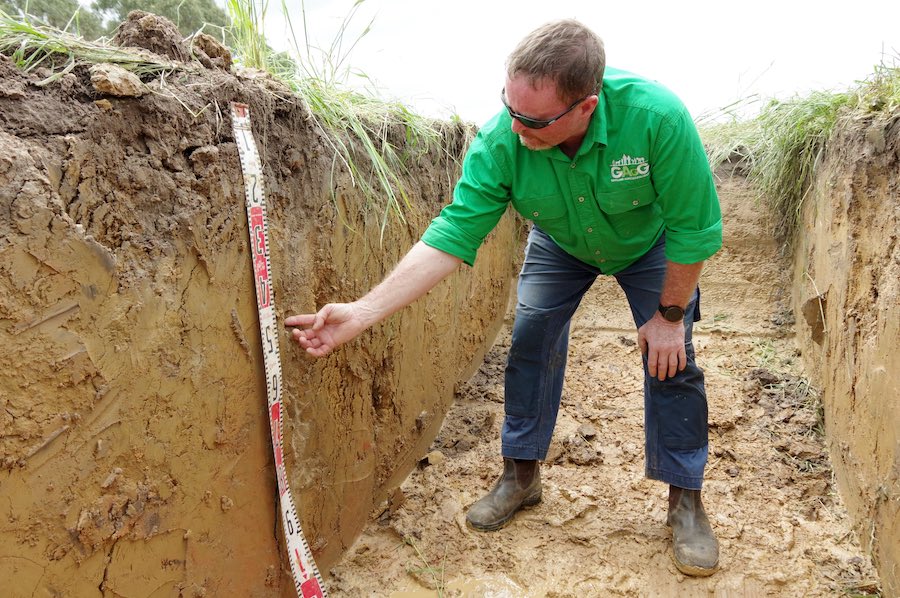Promising initial results from a demonstration trial incorporating organic amendments into clay soils will see further research undertaken across commercial growing environments in Gippsland, Victoria.
Results show more worm populations in the topsoil and increased pasture dry matter yield across three plots where subsoil organic amendments were added.
Following encouraging results from subsoil amelioration treatments with organic materials in cropping areas led by Agriculture Victoria (DAV1606-001RMX), farmers were keen to explore the applicability of this practice in Gippsland.
On 3 March 2022, deep ripping was conducted into the topsoil on a one-hectare demonstration site at the Gippsland Agricultural Group’s (GAGG) research farm, near Bairnsdale in Victoria.
Clay amendments
Amendments of chicken manure or compost were applied into an inhospitable clay below 12 centimetres, on three of five plots. The amendment was inserted into the clay using a hopper that blew it into the ground as the tyne progressed through the topsoil; then the earth fell back into the rip line.
Of the three deep ripped and amended plots, one was ameliorated with five tonnes per hectare of chicken litter, and one with 10t/ha of chicken litter. The third plot was treated with 10t/ha of commercial compost as an alternative amendment. In the other plots, one was an untreated control, while the other was ripped without any amendment added to quantify any effects of deep ripping alone.
“If we get any sort of benefit, especially water-holding capacity or infiltration, it will be a worthwhile project,” says Rick Blackshaw, the GAGG project officer overseeing the trial.
“Any sort of benefit gives farmers something extra to work with while waiting for the autumn and spring break.”
A barley variety was sown across the site; however, wet weather prevented spraying at an opportune time and the site was dominated by a considerable mass of ryegrass volunteers.
“The ryegrass population was substantial, therefore we changed the program from the barley crop to a barley and ryegrass pasture,” Mr Blackshaw says.
“In reality, that mimicked true farm conditions, where sometimes the weather and other pressures mean spraying doesn’t occur.”
Measurement of results
Results were measured in three ways – earthworm counts in the 12cm of topsoil, quadrant pasture cuts and digging a one-metre pit to observe the impact of each organic amendment of soil structure.
The first pasture cuts were taken at the start of August, prior to grazing by sheep. A second set of pasture cuts occurred in November, again prior to grazing. The quadrant cuts were analysed for moisture and dry matter levels.
“We are seeing what we envisaged,” Mr Blackshaw says.
“There appeared to be a response in pasture dry matter production where the organic amendments were applied,” Mr Blackshaw says.
The control plots produced six to seven t/ha of dry matter over the two cuts, while the plot ameliorated with 10t/ha of chicken manure yielded 10t/ha of dry matter.
The worm count was replicated three times in each plot, in June 2022.
“We also measured earthworm numbers four months after the treatments which showed more worms where the amendment was added than in the control plots.”
The control plots had between two to four worms per square metre, but where 5t/ha of chicken manure was added, this increased to 12 worms including a lot of small worms. In the plots where 10t/ha of chicken manure and 10t/ha of compost were added, there were counts of 15 to17 worms per square metre.
“Worms and worm castings are good for soil aeration and nutrient cycling. These are definite indicators of the improving biology of the soil.”

In late October, Rick Blackshaw was pleased to see evidentiary changes down to 50-centimetre depth in the one-metre demonstration trench. Photo: Jeanette Severs
In late October, a one-metre-deep trench was dug across each plot to visually assess soil structure and identify whether the treatments had enabled plant roots to penetrate deeper into the clay substrata.
Although it was less than a year since treatment, the early soil results were promising. “We clearly saw that the deep ripping had created a few fissures and the amendments were moving down into the subsoil,” Mr Blackshaw says.
“Unlike the untreated control, very fine root hairs were finding their way below the topsoil, through the soil ameliorant, and down 30 to 40cm into the clay subsoil on the amelioration plots.”
“Root development showed distinct differences between the plant from the control plot and plants from where amendments were added, which helps explain the responses in above ground biomass.”
A subclause to the results is the regular rainfall throughout the 2022 season. The atypical rainfall pattern improved the dispersion of the organic amendments into the soil.
However, early results show potential for using deep placement of organic amendments into hostile clay subsoils to increase pasture yields. The capacity of the soil to increase water infiltration and retention will be measured over the next four years.
“In the first year we saw some small gains – and, in farming, small gains every day add up to dollars,” Mr Blackshaw says.
“There are four more years to run on the trial and we hope the soil and plant responses increase each season.”
In addition, the 10t/ha of chicken manure treatment will be tested on four commercial farms at Yarram, Winnindoo, Toongabbie and Giffard in 2023.
The measurement parameters of the commercial trials will be the same as the demonstration trial – soil water infiltration and water-holding capacity, yield of crops and pastures, the cost of inputs against outputs and the overall economic returns.

























































